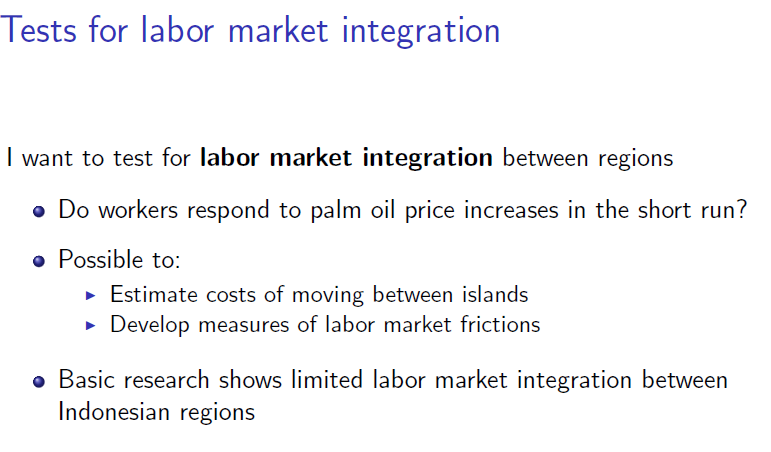 Reported by Adinda Rizky Herdianti
Reported by Adinda Rizky Herdianti
Allison Derrick, a PhD student at University of Wisconsin-Madison, presented her study titled “Buoyed by the boom? Regional effects of commodity price increases in Indonesia” which focuses on the effect of commodity price boom in Indonesia on 11 January 2017. Before going in to the presentation, she mentioned that any suggestions were welcomed since her study was still at a preliminary stage.
The study will focus on palm oil since it is considered as labor-intensive industry, thus having the potential to influence labor market, particularly rural labor market where poor people mostly concentrated. The term ‘boom’ itself refers to palm oil production that mounts rapidly from 11 million metric tons in 2000 to 18 million metric tons in 2008, not to mention the 69% hike in palm oil price from 2000 to 2008. The study will exploit the regional specialization in palm oil production to identify changes in the general equilibrium and spillover effects.
The model developed for analyzing regional specialization divides regions in Indonesia into producing districts and non-producing districts, each of them will be given positive and negative shock respectively. Based on no inter-regional mobility assumption, producing districts will enjoy employment and production expansion in booming industry and contraction in manufacture sector. However, Indonesia experiences imperfect inter-regional factor mobility where labor can move across districts and spaces subject to transportation costs. Also, wages and interest rates will not fully equalize between districts. She predicts that there will be increase in service, transportation, and construction employment and the spillover effects will be incurred by district non-traded goods.
Using short-term migration data from post-2007 National Labor Force Survey (Survei Tenaga Kerja Nasional or SAKERNAS), the study also wants to test for labor market integration between regions. She admitted that there are several challenges in analyzing labor market integration in Indonesia, one of which is only big corporations that are required to comply with minimum wage regulation. There is also possibility of districts with palm oil to produce other commodities. As the consequence, palm oil price is correlated with other commodity prices.
The general equilibrium model in this study consists of two stages to determine the effect of price changes to wage, employment, and local consumer price index (CPI). Before undergoing the first stage, which is instrument oil palm area or palm oil production, Allison decided to measure the exposure of palm oil price changes according to palm oil cultivation suitability. The second stage is fixed-effect regression in which the outcome variables are regressed against instrument oil palm area, district fixed effect, and geographical region-time fixed effect.
Some of the participants suggested that the study takes into consideration the environmental perspective concerning palm oil production expansion as well as law and order issue on palm oil land area that more or less also affects the palm oil land suitability.